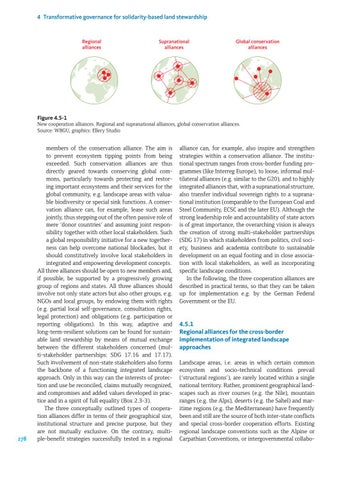4 Transformative governance for solidarity-based land stewardship
Regional alliances
Supranational alliances
Global conservation alliances
Figure 4.5-1 New cooperation alliances. Regional and supranational alliances, global conservation alliances. Source: WBGU, graphics: Ellery Studio
278
embers of the conservation alliance. The aim is m to prevent ecosystem tipping points from being exceeded. Such conservation alliances are thus directly geared towards conserving global commons, particularly towards protecting and restoring important ecosystems and their services for the global community, e.g. landscape areas with valuable biodiversity or special sink functions. A conservation alliance can, for example, lease such areas jointly, thus stepping out of the often passive role of mere ‘donor countries’ and assuming joint responsibility together with other local stakeholders. Such a global responsibility initiative for a new togetherness can help overcome national blockades, but it should constitutively involve local stakeholders in integrated and empowering development concepts. All three alliances should be open to new members and, if possible, be supported by a progressively growing group of regions and states. All three alliances should involve not only state actors but also other groups, e.g. NGOs and local groups, by endowing them with rights (e.g. partial local self-governance, consultation rights, legal protection) and obligations (e.g. participation or reporting obligations). In this way, adaptive and long-term-resilient solutions can be found for sustainable land stewardship by means of mutual exchange between the different stakeholders concerned (multi-stakeholder partnerships: SDG 17.16 and 17.17). Such involvement of non-state stakeholders also forms the backbone of a functioning integrated landscape approach. Only in this way can the interests of protection and use be reconciled, claims mutually recognized, and compromises and added values developed in practice and in a spirit of full equality (Box 2.3-3). The three conceptually outlined types of cooperation alliances differ in terms of their geographical size, institutional structure and precise purpose, but they are not mutually exclusive. On the contrary, multiple-benefit strategies successfully tested in a regional
alliance can, for example, also inspire and strengthen strategies within a conservation alliance. The institutional spectrum ranges from cross-border funding programmes (like Interreg Europe), to loose, informal multilateral alliances (e.g. similar to the G20), and to highly integrated alliances that, with a supranational s tructure, also transfer individual sovereign rights to a supranational institution (comparable to the European Coal and Steel Community, ECSC and the later EU). Although the strong leadership role and accountability of state actors is of great importance, the overarching vision is always the creation of strong multi-stakeholder partnerships (SDG 17) in which stakeholders from politics, civil society, business and academia contribute to sustainable development on an equal footing and in close association with local stakeholders, as well as incorporating specific landscape conditions. In the following, the three cooperation alliances are described in practical terms, so that they can be taken up for implementation e.g. by the German Federal Government or the EU.
4.5.1 Regional alliances for the cross-border implementation of integrated landscape approaches Landscape areas, i.e. areas in which certain common ecosystem and socio-technical conditions prevail (‘structural regions’), are rarely located within a single national territory. Rather, prominent geographical landscapes such as river courses (e.g. the Nile), mountain ranges (e.g. the Alps), deserts (e.g. the Sahel) and maritime regions (e.g. the Mediterranean) have frequently been and still are the source of both inter-state conflicts and special cross-border cooperation efforts. Existing regional landscape conventions such as the Alpine or Carpathian Conventions, or intergovernmental collabo-
